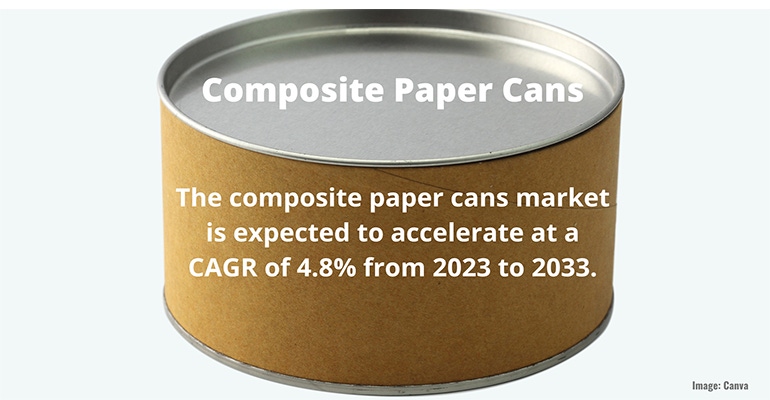The composite paper cans market is accelerating at a CAGR of 4.8% from 2023 to 2033 versus a 2.4% CAGR from 2016 to 2022.
March 14, 2023

The paper chase continues across many packaging types including composite paper cans, a market that’s expected to rise at a compound annual growth rate (CAGR) of 4.8% from 2023 to 2033 versus a 2.4% CAGR from 2016 to 2022.
Growth in the market, which is estimated to reach a valuation of $8,132.8 million by the end of the forecast period, is attributed to sustainability investments and increasing consumption of sustainable packaging solutions among end-users.
That’s according to a focused market report from Future Market Insights.
According to FMI research, Europe contributed to over a third of the global demand for composite paper cans in the year 2022. Germany has emerged as a leading market for composite paper cans in Europe with an expected value of $261.6 million in 2022.Germany is estimated to account for a share of 15% of the Europe market by the end of 2033.
One of the key aspects supporting growth in the country is that key players have a strong presence in the Europe market leading to cost-effective domestic sales in the region. The presence of some of the leading market players and the easy availability of raw materials in the country support growth in the market.
US continues to lead the global composite paper cans market.
Within North America, the US is expected to account for 16.2% of total sales of composite paper cans globally.
US composite paper cans sales account for 66.3% of the North America market and are expected to witness moderate growth through the forecast period. Large multinational vendors are adapting to composite paper cans owing to the presence of paper board manufacturers in the country.
The surging demand for takeaway food, frozen food items, and on-the-go beverages has been enabling growth in the country. Rising application in the packaging of personal care and cosmetic products might also aid sales in the United States.
According to FMI, the China market is growing steadily, with numerous small-scale companies manufacturing composite paper cans. Currently, China accounts for a market share of 58.2% in East Asia. Over the forecast period, the Chinese composite paper cans market is projected to grow at an annual rate of 9.1%.
The country is expected to register increasing demand for composite paper cans on the back of rising sales in the food and beverages industry. Also, industrialization, supported by the easy availability of raw materials and cheap labor, supports growth in the country.
In terms of consumption, 50-mm/2-inches to 100-mm/4-inches diameter composite paper cans are expected to outpace other segments and are estimated to reach nearly 58 billion units sold by 2031.
The adoption of sustainable materials in the production of composite paper cans attracts environment-conscious customers. Food and beverage packaging applications accounted for nearly 49.8% of the market in 2022. Composite material provides increased durability versus ordinary paper cans.
Some of the leading companies manufacturing composite paper cans are Smurfit Kappa Group plc, Amcor plc, Mondi Group plc, Sonoco Products Company, Ace paper tube, Irwin packaging, PTS manufacturing, Canfab packaging, and others. European manufacturers account for more than 38% of the market.
Composite paper can suppliers are evolving to meet ecommerce demands.
According to FMI analysis, some leading companies are revising their supply chain strategies to cater to the evolving demand of online purchases. Usually, takeaway beverages and frozen items are at a higher risk of damage during transport.
Composite paper cans make use of internal laminated coatings to maintain the shelf life of products. Also, growth in aluminum membranes provides a barrier to ensure minimal product contact. Beverages are closed using snap-on or plug caps to prevent spillage. This makes composite paper cans an ideal solution for on-the-go snacking and takeaways. These properties reduce consumer inconvenience arising from product damage.
Mondi Group PLC used 37% less plastic materials in their portfolio, saving around 35 tons of plastic in 2020. The company also has its own sustainably managed forest, which is the main source of raw materials. The company leveraged its unique “EcoSolutions” for product designs to encourage recycling.
Amcor plc announced an investment of $100 million for the development of new packaging solutions for sustainability objectives. The company has joined various government initiatives, such as the Healthcare Plastics Recycling Council, where sustainable products used in the healthcare segment focus on the recyclability of packaging products.
EnvoPAP announced a research and development program to develop composite cans from agricultural waste instead of conventional wood sources required for paper could increase production, to further reduce environmental impact.
About the Author(s)
You May Also Like


